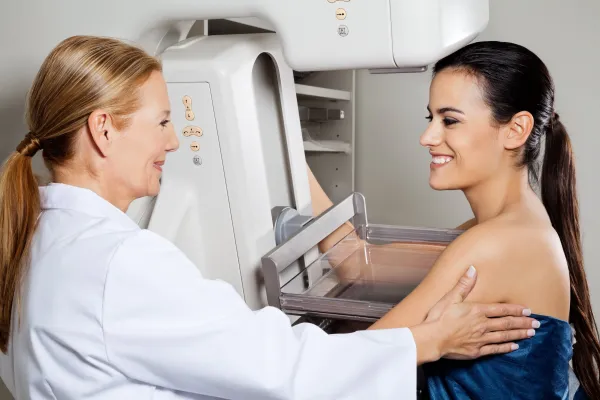Part B Insider (Multispecialty) Coding Alert
Master Mammography Coding with This Expert Guidance

Tip: Use a modifier when a screening turns diagnostic.
Not every mammography case is clear cut and easy to report. Take a look at this mammogram 101 and become a pro at differentiating basic, intermediate, and challenging.
First up is a quick rundown of what the mammography codes are, CMS’ rules for these services, and how to know which code to use for each type of patient. Read on to find out exactly how you should report straightforward mammography services in your practice.
Differentiate Screening From Diagnostic
For mammography reporting, your first step will always be to determine whether a diagnostic or screening procedure was performed. This may sound simple, but keep in mind that the words “screening” and “diagnostic” may not always appear in the records.
According to United HealthCare’s mammography policy, which was updated last May, the following is the difference between the two:
- A screening mammography is furnished to a woman without signs or symptoms of breast disease, “for the purpose of early detection of breast cancer, and includes a physician’s interpretation of the results of the procedure. A screening mammography has limitations as it must be, at a minimum a two-view » exposure (craniocaudal and a medial lateral oblique view) of each breast.”
- A diagnostic mammography is furnished to a man or woman with signs and symptoms of breast disease, “or a personal history of breast cancer, or a personal history of biopsy-proven benign breast disease, and includes a physician’s interpretation of the results of the procedure.”
Here are Medicare’s coverage guidelines: Medicare doesn’t cover screening mammograms performed on a woman under the age of 35. “Payment may be made for only one screening mammography performed on a woman over age 34, but under age 40,” CMS says in its National Coverage Determination (NCD) for mammography. “For an asymptomatic woman over age 39, payment may be made for a screening mammography performed after at least 11 months have passed following the month in which the last screening mammography was performed.”
The NCD also indicates that diagnostic mammograms are covered when “ordered by a doctor of medicine or osteopathy,” under the following conditions:
- A patient has distinct signs and symptoms for which a mammogram is indicated;
- A patient has a history of breast cancer; or
- A patient is asymptomatic but, on the basis of the patient’s history and other factors the physician considers significant, the physician’s judgment is that a mammogram is appropriate.
Use G Codes for Mammography
When submitting mammography claims to Medicare payers, you should use a code from the following list:
- G0202, Screening mammography, bilateral (2-view study of each breast), including computer-aided detection (CAD) when performed,
- G0204, Diagnostic mammography, including computer-aided detection (CAD) when performed; bilateral, and
- G0206, Diagnostic mammography, including computer-aided detection (CAD) when performed; unilateral.
New codes don’t mean new coding processes: The 2017 edition of the CPT® manual has caused confusion about using the above G codes, since the AMA rolled out new codes for mammography procedures, both diagnostic and screening. The new codes are 77065 (Diagnostic mammography, including computer-aided detection [CAD] when performed; unilateral), 77066 (Diagnostic mammography, including computer-aided detection (CAD) when performed; bilateral), and 77067 (Screening mammography, bilateral [2-view study of each breast], including computer-aided detection [CAD] when performed).
CPT® added these new codes to bundle computer-aided detection (CAD) in with unilateral or bilateral diagnostic mammography and screening mammography. Since most radiology facilities now use computer-aided detection (CAD) the new codes reflect that in the descriptors. However, CMS is not accepting the new codes in this year due to issues in processing claims with these codes.
Federal guidance: CMS released its Frequently Asked Questions for Mammography Services document to address common concerns for mammography services. In the article, CMS clearly states its inability to accept these codes in 2017. “For reasons related to claims processing systems, CMS will be unable to properly process claims using CPT® codes 77065, 77066, and 77067 for 2017,” the agency says in its FAQ document. “Therefore, for 2017, practitioners should report mammography services using G codes G0202, G0204, and G0206.”
Payer preference: Many private payers are asking coders to submit mammography claims under the CMS rules, but you should check with your payers before you submit a claim for mammography. For instance, Aetna lists both sets of codes (77065-77067 and G0202-G0206) as payable, as have some Blue Cross Blue Shield policies. “Blue Cross Blue Shield of North Carolina will reimburse for HCPCS (G code) or CPT® code, but not both for the same date of service,” that payer’s policy says.
Note: For the purposes of this issue, Radiology Coding Alert will use CMS guidelines (G codes) rather than the new CPT® codes to eliminate confusion, since more payers are accepting the G codes in 2017 than the CPT® codes.
Know How to Code Screening That Turns Diagnostic
Your physician may perform a screening as well as a diagnostic mammogram on the same day. This may happen when a patient presents for a screening mammogram, and your radiologist detects a suspicious abnormality, advises Allison Anderson, owner of AAA Billing in Newark, N.J. This type of situation will often necessitate a separate unilateral or bilateral diagnostic mammogram on the same date.
In this case, you should report both services and append modifier GG (Performance and payment of a screening mammogram and diagnostic mammogram on the same patient, same day) to the diagnostic mammogram code.
For the screening mammogram, you’ll submit code G0202 (Screening mammography, bilateral [2–view study of each breast], including computer–aided detection [CAD] when performed). For the diagnostic bilateral mammogram, you will submit code G0204 (Diagnostic mammography, including computer-aided detection (cad) when performed; bilateral) and append modifier GG (Performance and payment of a screening mammogram and diagnostic mammogram on the same patient, same day) to it.
Confirm same date of service: The GG modifier allows you to separate G0202 and G0204, which you cannot typically report on the same date of service for the same patient. In the above scenario, if the provider performed the mammographies on different dates, then you wouldn’t need modifier GG (or any modifiers) on the claim, since the codes would correspond to separate dates of service.
Note: Read the CMS FAQ here: https://www.cms.gov/Medicare/Medicare-Fee-for-Service-Payment/PhysicianFeeSched/Downloads/FAQ-Mammography-Services-Coding-Direct-Digital-Imaging.pdf.
Related Articles
Part B Insider (Multispecialty) Coding Alert
- RAC Audits:
Focus on AWV Basics or Risk Your Claims Coming Under Review
Don’t confuse a “Welcome to Medicare” visit with an annual wellness visit. Annual wellness visits [...] - Master a RAC Audit with Advance Planning
Tip: Keep abreast of MAC and federal changes to avoid confusion. Preparation is the key [...] - Clip And Save:
Keep Your Practice Compliant with This Top 5 List of HIPAA Fails
Don’t drop the ball on network monitoring — that’s how the hackers sneak in. HIPAA [...] - MACRA:
Worried Your MIPS Invite Got Lost in the Mail? Check Online and Verify Your Status
New CMS tool lets anxious Part B providers see if they are required to report [...] - Part B Coding Coach:
Master Mammography Coding with This Expert Guidance
Tip: Use a modifier when a screening turns diagnostic. Not every mammography case is clear [...] - Physician Notes:
Review New Smart Form Guidance from Cahaba
Plus: A Chicago physician is looking at possibly 120 years for Medicare fraud. If the [...]




